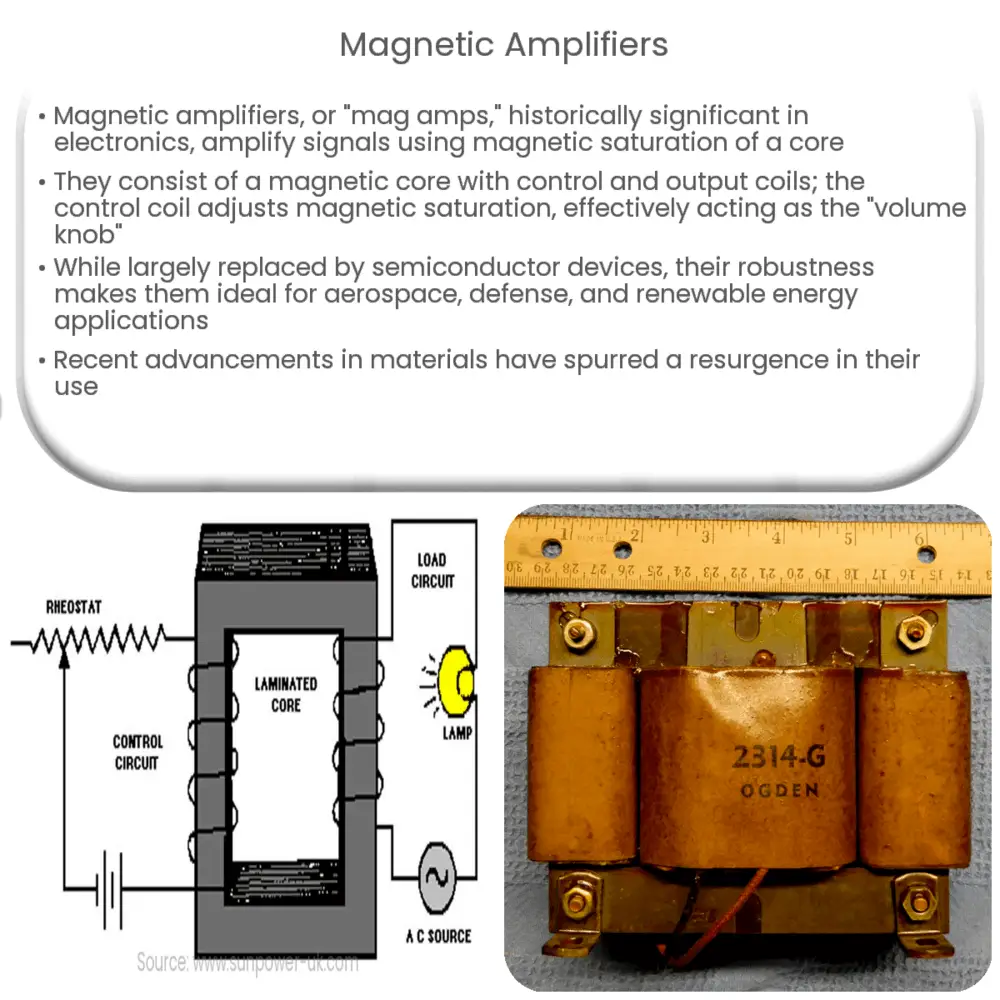Explore the intriguing world of Magnetic Amplifiers – from their principle and components to modern applications and future potential.

Introduction to Magnetic Amplifiers
Magnetic amplifiers, colloquially known as “mag amps,” have a fascinating historical and practical significance in electronics and communication technology. First patented in the early 20th century, these devices enjoyed widespread use until they were largely supplanted by semiconductor devices. However, they still hold a niche in some areas due to their unique attributes.
Working Principle of Magnetic Amplifiers
A magnetic amplifier is essentially a transformer-based device used for power control and signal amplification. The primary principle behind its operation is the magnetic saturation of the core, which allows for modulation of the output based on an input control signal. The device’s characteristics, such as its resistance to electrical noise, robustness, and simplicity, make it an intriguing piece of technology.
Core Components of a Magnetic Amplifier
The heart of a magnetic amplifier is a magnetic core, usually made of high-permeability magnetic material. This core is wound with two types of coils: a control coil and an output coil. The magnetic saturation of the core is manipulated by adjusting the current in the control coil, effectively controlling the transfer of power from the input to the output coil.
The Role of the Control Coil
The control coil is tasked with inducing magnetic saturation in the core. A small control current is applied, which is adjusted in line with the desired level of output. Thus, the control current can be likened to the ‘volume knob’ of the magnetic amplifier. When the core reaches magnetic saturation, it loses its ability to transfer more energy from the input to the output. By controlling the level of saturation, the control coil regulates the output of the device.
The Role of the Output Coil
The output coil is where the amplified signal is obtained. This coil is wound around the same core as the control coil. It receives power from the input circuit and transfers it to the output circuit. However, the extent of power transferred is contingent on the level of magnetic saturation of the core, controlled by the control coil.
Applications of Magnetic Amplifiers
- The inherent robustness and resistance to electrical noise make magnetic amplifiers ideal for harsh environmental conditions, such as those found in aerospace and nuclear applications.
- They are also utilized in power conversion systems, such as inverters and power supplies, due to their ability to handle large amounts of power.
- Magnetic amplifiers also found use in analog computers before the advent of digital technology.
Advantages and Disadvantages of Magnetic Amplifiers
Despite being phased out by semiconductor devices for many applications, magnetic amplifiers come with several advantages. They are robust and reliable devices, able to withstand extreme temperatures and conditions. Moreover, they exhibit excellent tolerance to electrical noise, making them particularly suitable for noisy electrical environments.
However, they also possess a few shortcomings. Magnetic amplifiers tend to be relatively large and heavy compared to their semiconductor counterparts. Also, they operate at lower frequencies and can introduce non-linear distortions. Furthermore, they typically require a larger startup current compared to other amplification methods.
The Revival of Magnetic Amplifiers
Interestingly, magnetic amplifiers have recently seen a resurgence in certain fields. One significant reason for this is the advent of new materials and manufacturing processes, which can make these devices smaller, lighter, and more efficient. Modern magnetic materials allow for operation at higher frequencies and better control over magnetic saturation, enhancing the device’s overall performance.
Modern Applications of Magnetic Amplifiers
- Renewable Energy: With the boom in renewable energy technologies, magnetic amplifiers have found a place in power conversion systems for wind and solar energy harvesting.
- Power Electronics: Their ability to handle large power levels and resist electrical noise makes them an excellent choice for certain power electronics applications.
- Aerospace and Defense: Due to their robustness and resistance to harsh conditions, they are used in certain aerospace and defense applications.
Conclusion
In conclusion, while magnetic amplifiers may seem like a relic of the past, they still hold value in today’s technology landscape. Their unique characteristics, coupled with modern materials and manufacturing techniques, make them suitable for specific applications where robustness, high power handling, and noise resistance are required. As technology continues to evolve, we can expect to see more innovations and applications in the realm of magnetic amplifiers. Despite being overshadowed by semiconductor devices, the magnetic amplifier remains a testament to the ever-evolving nature of electronic and communication technology.

